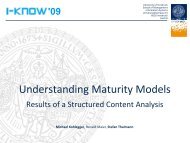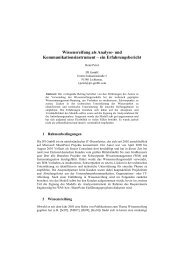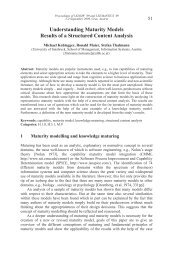MATURE Deliverable 1. - Knowledge Maturing
MATURE Deliverable 1. - Knowledge Maturing
MATURE Deliverable 1. - Knowledge Maturing
Create successful ePaper yourself
Turn your PDF publications into a flip-book with our unique Google optimized e-Paper software.
4.2 Personas<br />
Modelling Personas is one promising approach to characterize user needs, work routines and learning<br />
styles as proposed by (Cooper, 1999). Personas are useful in order to understand potential users in terms<br />
of their needs, goals and characteristics regarding their future intended system usage. A Persona is a<br />
precise description of a user’s characteristics and what he/she wants to accomplish (Cooper, 1999) and<br />
represents a class of target users that is described with rich information (Aoyama, 2007). Besides its<br />
usage for software designers, Personas can be used for communication with clients and stakeholders<br />
(Chang et al., 2008). We are well aware of the fact that there is a plethora of related work investigating<br />
person types from a psychological perspective (Bayne, 2004, Bayne, 2005, Bayne, 2006). However, these<br />
general person types have not been analysed from a learning perspective and thus do not give any details<br />
about how they handle knowledge (maturing).<br />
According to Cooper, a Persona should be based on sound empirical fieldwork (Cooper, 1999).<br />
Furthermore, Cooper and Reimann argue that a Persona should be mainly based on qualitative data<br />
gathered through interviews or ethnographic fieldwork (Cooper and Reimann, 2003), however, it may<br />
also include imaginary information (Junior and Filgueiras, 2005). A Persona can be developed according<br />
to a single human being (Cooper, 1999) or as a mash-up of users with aggregated characteristics (Chang<br />
et al., 2008). In any case, descriptions should be consistent and one Persona should be understood as one<br />
individual. A big advantage is that the targeted audience of Personas develops its own picture of the<br />
Persona as a human being. There is evidence that the audience typically tries to consider the Personas’<br />
characteristics in communication and design activities (Chang et al., 2008). In order to reach its full<br />
potential, Personas must come to life in the designers’ minds. Pictures or images of Personas can be used<br />
in order to make them more memorable and to add realism (Junior and Filgueiras, 2005). Designers can<br />
talk more easily about the needs and goals of a Persona than about abstract requirements (Blomquist and<br />
Arvola, 2002).<br />
Personas are part of the user-centred design approach which primarily focuses on requirements of the<br />
potential user group. Randolph suggests that a system should be designed according to one primary<br />
Persona whose needs are considered predominantly (Randolph, 2004). Thereby, Personas form important<br />
communication media within the team of designers (Blomquist and Arvola, 2002). They are useful in<br />
helping to guide decisions about a product, such as features, interactions, and visual design. The<br />
following list shows a selection of benefits of using Personas identified by Cooper as well as by Pruitt and<br />
Adlin (Cooper, 1999, Pruitt and Adlin, 2006b):<br />
‐ Personas help make user-centred design possible by putting users or more precisely information<br />
about targeted users at the centre of design.<br />
‐ Personas help team members share a specific, consistent understanding and can be used to help<br />
guide decisions, e.g., about the product’s navigation scheme and visual design.<br />
‐ The development of solutions can be guided by how well they meet the needs, attitudes and<br />
behaviour patterns of Personas.<br />
‐ Personas provide a human "face" so as to focus empathy on the people represented by the<br />
demographics.<br />
Personas have also been introduced building on lessons learned from the EU-funded projects APOSDLE<br />
(see Dotan et al., 2009) and NEPOMUK (see Gudjónsdóttir and Lindquist, 2008).<br />
In <strong>MATURE</strong>, Personas have been used in order to reap these benefits. Personas provide one possibility to<br />
generalize individual observations that have been made during the ethnographic study (see section 3).<br />
Furthermore, usage of Personas goes along with the aim of modelling users in a semi-formal manner and<br />
supporting the communication process during delivery or mediation, respectively, of outcomes of the<br />
ethnographic study to those developers who have not participated in the ethnographic study 2 .<br />
2 As mentioned in section 3.1, some software developers have directly been involved in the ethnographic study so<br />
that they could directly take on board their first-hand experiences into the software design process, the design<br />
studies with application partners as well as the prototype development process.<br />
24







